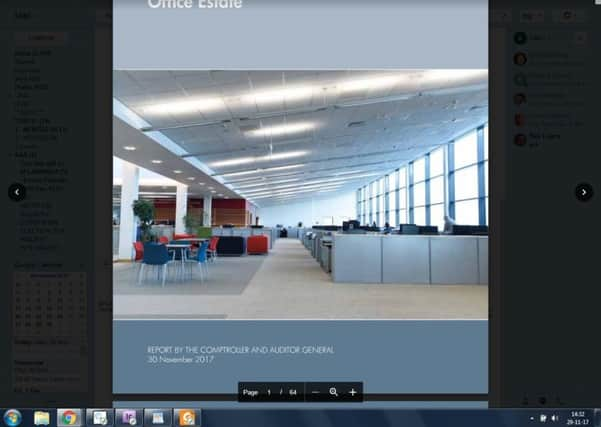Over £17m spent each year on empty government desks


That is one of the findings of a detailed investigation into the state and cost of the office space owned or rented by all nine Stormont departments (and their subsidiary public bodies such as the fire brigade) in Northern Ireland.
It does not include councils, schools, fire and police stations, and so on.
Advertisement
Hide AdAdvertisement
Hide AdThe office estate which the auditors looked at is made up of 276 offices, and cost around £96m to run each year, as of 2014/15.
The Northern Ireland Audit Office report, released today, is critical of a number of areas of how the properties are managed.
It is the first time since 2012 that there has been such a comprehensive audit of the office space, and only a fifth of the recommendations it had made at that time have actually been properly addressed.
In summary, Kieran Donnelly, the Auditor General said: “The current configuration and management of the office buildings used by government departments is not delivering value for money.
Advertisement
Hide AdAdvertisement
Hide Ad“The existing office estate consists, to a significant extent, of highly inefficient, cellular, and aging accommodation.”
The report added that when it comes to trying to improve the situation, “progress has been too slow”.
Among the report’s findings are that the annual cost of catering for vacant “workstations” – defined as being a space comprised of at least a desk and chair – had risen from £15.4m in 2011/12 up to £17.3m in 2014/15 (the latest such figures which the auditors were able to get hold of, because there is centralised place where such data is collected).
It is understood this was worked out by looking at what the average cost of a workstation is in terms such things as heat, lighting, rent, rates, and so on; in 2014/15 this figure stood at £2,709.
Advertisement
Hide AdAdvertisement
Hide AdAuditors then multiplied this by the number of vacant workstations (6,382 in 2015, a figure 15% higher than it had been three years earlier) – arriving at the figure of £17.3m.
In addition, auditors found that over £441,000-worth of “irregular expenditure” had been made from 2011/12 to present.
This refers to occasions when various public bodies decided to extend their leases on properties without first asking the Department for Finance if they could spend the money.
When these decisions were later brought to the attention of finance officials, no retrospective permission was granted – committing the department to pay for the leases even though they had not given them the green light.
Advertisement
Hide AdAdvertisement
Hide AdA similar thing had happened during the fiasco-prone RHI scheme, when the RHI programme was left running for part of 2015 without any permission from the Department of Finance.
Permission to continue spending money had expired in April that year, but the RHI officials forgot to renew it until May.
The instances of “irregular expenditure” in this case involved the Health and Social Care Business Services Organisation’s Lesley House building in Belfast (on which there was £104,000 of irregular expenditure) and the Health and Social Care Board’s use of County Hall in Ballymena (£186,000).
It also involved the NI Fire and Rescue Service’s use of properties on Henry Street, Ballymena (£75,000), as well as in Cookstown District (£49,000) and Downpatrick (£27,000).
Advertisement
Hide AdAdvertisement
Hide AdToday’s report also goes through 10 recommendations it had made in 2012 about how properties should be better managed.
These included all public bodies collating “baseline data” on property assets and setting themselves “challenging” targets; introducing mechanisms to allow departments’ performance to be transparent and reported to the Assembly; and centralising control of property assets within the Department of Finance, which would then charge different public bodies to use them. The thinking behind this last one is that at the minute, departments and bodies tend to manage their buildings themselves, but the Department of Finance could take total control of the properties and use its greater expertise to bring the costs down.
Out of these 10 recommendations from five years ago, only two were fully met (the ones just mentioned were among those not met).
Trevor Lunn, an Alliance MLA who sits on the Public Accounts Committee, has received a copy of the report, but the fact Stormont is not sitting means he and his fellow MLAs cannot actually debate it.
Advertisement
Hide AdAdvertisement
Hide AdHe said: “I think it’s of sufficient gravity it’d certainly come before the Public Accounts Committee. I know we’d have valued the opportunity to investigate it further.”
He said it is possible that some of the decisions which must now be taken would be “beyond the remit” of civil servants, and just shows the need for the Executive to be re-established.
He added: “Empty property, empty desks, still cost money. The provision of space needs to be kept in line with the requirements.”
He said that there is a time to sell and a time to hold on to property, but with the civil service redundancies happening at present there is likely to be less space, and “there should be opportunities for disposal of property”.
Advertisement
Hide AdAdvertisement
Hide AdHe said: “I think the Audit Office has done its job in pointing out that you’re talking about £100m just to run the estate, and if there’s savings to be made they should be given priority at the present time.”